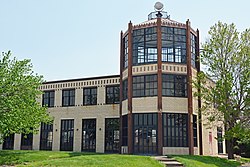Old Port Columbus Terminal
Old Port Columbus Airport Control Tower | |
 | |
 Interactive map highlighting the building's location | |
| Location | 4920 E. 5th Ave., Columbus, Ohio |
|---|---|
| Coordinates | 39°59′13″N 82°52′18″W / 39.986854°N 82.871790°W |
| Built | 1929 |
| NRHP reference No. | 79001839[1] |
| CRHP No. | CR-67 |
| Significant dates | |
| Added to NRHP | July 26, 1979 |
| Designated CRHP | September 21, 2015 |
The Old Port Columbus Terminal, also known as the Old Port Columbus Airport Control Tower, is a historic building in Columbus, Ohio. It was built in 1929 as one of the first airport facilities in the United States. It was replaced by the current facilities in 1958.[1][2] It was listed on the National Register of Historic Places in 1979. It is located on the southeast corner of John Glenn Columbus International Airport, formerly known as Port Columbus International Airport.[2]
Attributes
The terminal was designed in the Art Deco style popular at the time. The building has 12,000 square feet (1,100 m2).[3]
History
The terminal was constructed in 1929 and opened on July 8 of that year. At its opening, it was the easternmost airport in the Transcontinental Air Transport airline's coast-to-coast route, requiring visitors from New York to take a train to Columbus, fly to Oklahoma, take a train to New Mexico, and board a second flight to Los Angeles.[3]
The building was listed on Columbus Landmarks' Most Endangered Sites in 2015.[4] In that year, Heartland Bank shuttered its plans to lease and renovate the building and withdrew its historic tax credit application, stating that it was not economically feasible to restore the structure. In 2016, the building's roof was replaced and mold was removed.[3]
In 2020, the nonprofit Ohio Air & Space Hall of Fame and Museum (OAS) announced it signed a long-term lease to the building. The organization is planning for a $2 million renovation of the building, which was to be followed by the opening of its museum and hall of fame in late 2021. The organization also plans for a historical archive, a STEAM education center, and an event and meeting space in the terminal building.[5] By 2022, the organization had raised $1.2 million, and estimated the total project at $4 million. The organization's director plans to start the first construction phase in 2023, with a goal of raising $700,000 to accommodate the work.[3]
See also
References
- ^ a b "National Register Information System". National Register of Historic Places. National Park Service. November 2, 2013.
- ^ a b "National Register of Historic Places Registration Form". National Park Service. Retrieved May 20, 2020.
- ^ a b c d "Plans to convert original Port Columbus terminal into aviation hall of fame are taking off". The Columbus Dispatch. Retrieved 2022-12-04.
- ^ "Original Port Columbus Terminal – Columbus Landmarks".
- ^ "Plan to Restore Historic Terminal Moving Forward". October 2020.
